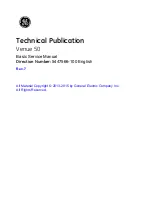
EATON Airflex WSB 11210 WCSB3 Installation Operation and Maintenance E-CLCL-11001-E October 2013
19
Warning
Failure to perform wear adjustments when required
may result in loss of adequate brake torque and
potential injury to personnel or damage to equip-
ment. Be certain to inspect the brake periodically to
evaluate for wear, and adjust as necessary.
4.2.1 Brake Inspection and Evaluation
To determine when brake adjustment is required, the
brake should be evaluated as follows:
4.2.1.1 Visually inspect for friction material wear.
Note: The friction material is fully worn when the wear has
reached the bottom of the wear groove as shown in Figure 6.
Note: If fully worn, replace the friction material and evaluate the
condition of the mating wear surface.
Note: If the wear limits on any of the friction discs have not been
reached, determine if brake adjustment is required by proceeding
to the next steps.
4.2.1.2 Measure for brake wear:
(a)
Ensure that the load that the brake supports will be
properly secured from possibility of movement when
no pressure is being applied to the brake being
inspected.
(b)
Exhaust all air pressure from the pressure chambers
on both ends of the WCSB3 brake being evaluated.
Pressurized areas are located in the following:
• Cylinder (19)
• Mounting Flange (112).
If more than one WCSB3 brake is used in the drive-
line, exhaust all air pressure from those brakes also.
Note: Follow the recommendations of the control system
manufacturer to ensure that no air pressure is trapped in the
brake or control system, and that the control system has been
safely isolated from the brake while performing inspections.
(c)
Verify that the air pressure has been fully exhausted
from these chambers by checking any in-line gauges
(they should read zero pressure), and also by
inspecting specific gaps between components
as noted below. Refer to Figure 7 & Figure 7A for the
corresponding gap locations.
Pressure in the cylinder (19) has been exhausted
if the measured gap Z-1 is greater than zero, and
there is no clearance between each side of the disc
(119) and the corresponding friction material.
Pressure in the mounting flange (112) has been
exhausted if gap Z-2 (See Figure 7A), located
between the mounting flange and the pressure plate
(116) is equal to .250” (6.35mm) and gap W is greater
than zero.
(d)
Measure gaps between the components at positions
W, X, Y-1, and if applicable, Y-2, and Y-3. See Figure 7
& Figure 7A for the location of those gap positions.
For reference:
The W-gap is the measurement between the end
plate (117) and the stop plates (125) and is used to
determine when adjustment of the water-cooled
section of the brake is required. This gap will increase
as the brake wears.
The X-gap is the measurement between the end plate
(117) and the pressure plate sub-assembly (13) and is
used to determine when adjustment of the air-cooled
section of the brake is required. This gap will
decrease as the brake wears.
The Y gaps are measurements between the various
wear plate sub-assemblies and are used to help
evaluate the wear of the water-cooled friction discs
and wear plates. These gaps will decrease as the
brake wears. The wear limit for each of the Y gaps is
the same for Y-1, Y-2 or Y-3.
Y-1 is the measurement between the mounting
flange (116) and the reaction plate (30).
Y-2 is the measurement between the reaction plate
(30) and the adjacent reaction plate (30). The Y-2
gap is found only on brakes that have three or more
water-cooled’ discs.
Y-3 is the measurement between the reaction plate
(30) and the end plate (117).
(e)
Record the W, X, Y-1, Y-2, and Y-3 values measured
for each of the gaps, and compare them against the
values listed in Table 14.
(f)
If the value measured for any Y gap (Y-1, Y-2, Y-3)
is equal to or less than the Y-min value, the brake
should be removed from service and repaired with
new wear components.
(g)
If the value measured for all Y gaps (Y-1, Y-2 or Y-3)
is greater than the Y-min value, proceed to evaluate
the measurement for gap W as follows:
(h)
If the measurement for gap W is equal to or greater
that the adjust value shown on Table 14, wear
adjustment is required. Adjust the brake per the
procedures listed in section 4.2.2.
DUST/WEAR
GROOVES
Figure 6
WCSB3 Brakes
















































